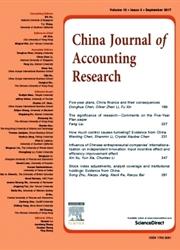海外业务和企业金融资产配置
IF 4
Q2 BUSINESS, FINANCE
引用次数: 0
摘要
利用2008-2018年中国上市公司数据,我们发现参与海外经营的企业(以海外子公司为代表)的金融资产配置普遍高于其他企业。从微观层面来看,当母公司面临严重的融资约束、没有海外归国高管、业务与海外子公司不一致以及海外子公司出现亏损时,这种效应会更加明显。从宏观层面来看,如果海外业务位于经合组织国家和 "一带一路 "国家,或者位于经济或政治风险较高、投资机会较多的地区,则影响更为明显。金融资产配置有助于缓解跨国公司的现金流波动和运营风险。本研究推动了对金融资产配置决定因素的研究,并对中国政府的 "走出去 "和 "一带一路 "战略以及努力实现发达金融业服务中国经济具有重要意义。本文章由计算机程序翻译,如有差异,请以英文原文为准。
Overseas operations and corporate financial asset allocation
Using data on Chinese listed companies for 2008–2018, we find that firms participating in overseas operations, proxied by overseas subsidiaries, generally have higher financial asset allocations than other firms. At the micro level, the effects are more pronounced when the parent company faces serious financing constraints, has no overseas returned executives, has a business that is inconsistent with that of its overseas subsidiaries and has overseas subsidiaries that experience losses. At the macro level, the effects are more pronounced when overseas operations are in OECD and Belt and Road countries, or in areas with higher economic or political risks and greater investment opportunities. Financial asset allocation helps mitigate cash flow fluctuations and operational risks for multinational firms. This study advances research on the determinants of financial asset allocation and has implications relevant to the Chinese government’s “Go Global” and Belt and Road strategies and its efforts to realize a developed financial sector to service the Chinese economy.
求助全文
通过发布文献求助,成功后即可免费获取论文全文。
去求助
来源期刊

China Journal of Accounting Research
BUSINESS, FINANCE-
CiteScore
4.70
自引率
0.00%
发文量
295
审稿时长
15 weeks
期刊介绍:
The focus of the China Journal of Accounting Research is to publish theoretical and empirical research papers that use contemporary research methodologies to investigate issues about accounting, corporate finance, auditing and corporate governance in the Greater China region, countries related to the Belt and Road Initiative, and other emerging and developed markets. The Journal encourages the applications of economic and sociological theories to analyze and explain accounting issues within the legal and institutional framework, and to explore accounting issues under different capital markets accurately and succinctly. The published research articles of the Journal will enable scholars to extract relevant issues about accounting, corporate finance, auditing and corporate governance related to the capital markets and institutional environment.
 求助内容:
求助内容: 应助结果提醒方式:
应助结果提醒方式:


